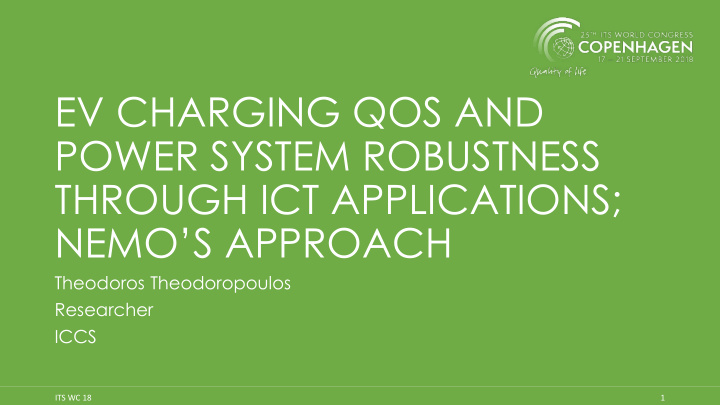



EV CHARGING QOS AND POWER SYSTEM ROBUSTNESS THROUGH ICT APPLICATIONS; NEMO’S APPROACH Theodoros Theodoropoulos Researcher ICCS ITS WC 18 1
CHALLENGES FOR NEMO (E-MOBILITY)? Limitation in Electric Vehicle range lack of interoperability in electromobility services Diverse eRoamingplatforms Impact to the Electric grid network Lack of common data exchange and commercial framework ITS WC 18 2
STRATEGY EMP #1 DSO #A ITSP #A CPO #A Hyper-Network of tools, models and services, to End-user Distributed, decentralized, Secured enable the provision of seamless and interoperable electromobility services creating (Shared distributed Database / Ledger) an open, distributed and widely accepted Business Network (B2B) ecosystem for e-mobility CPO DSO ITSP #B eRoaming Hub #1 CPO EMP ITS WC 18 3
OBJECTIVES • Enhanced driver satisfaction: “Charge anywhere & anytime” across Europe via a single identification, authorisation & payment method • Easy creation and delivery to a wide audience of innovative, interoperable electromobility services via an open cloud marketplace Improved attractiveness of electric vehicles Facilitation of EVs mass adoption ITS WC 18 4
OBJECTIVES , to support the EVs integration in the electricity grid, by optimisation of electricity supply compared to demand. ITS WC 18 5
ARCHITECTURE • New services will generate and exchange data according to the CIM • Data translators will enable the translation of data to the NeMo CIM Standardised model for information sharing across the NeMo Hyper-Network Implementation of the CIM ITS WC 18 6
ARCHITECTURE NeMo Business Network Charge Point CPO #2 Operator Shared distributed Database / Ledger: CPO CPO #1 1.Partner Management CIM Electro Mobility 2.Services Store (service) Provider EMP 3.Contract Management EMP CPO EMP Trustee Service CPO Provider DSO eRoaming EMP ITSP Hub #2 eRoaming Hub #1 CPO CPO DSO CPO EMP OEM #2 EMP 3 rd Party Service Provider ITS WC 18 7
NEMO NODE CLOSEUP • Servive lookup-Service creation-Service execution ITS WC 18 8
GRID SERVICES Navigation to CP based on user and grid power requirements Vehicles are routed to the appropriate charging point, according to vehicle and grid quality of service criteria Global customer charging behavior Profiling of end user charging behavior in order to enable demand forecasting Load management Ensure quality of service of charging operations according to user requirements and grid constraints Load forecasting due to EV charging anticipated load information to the DSO for energy generation planning and energy pricing Local energy management Include local energy providers to the energy mix provided by charging operations ITS WC 18 9
GRID SERVICES • Load management ITS WC 18 10
THANK YOU QUESTIONS? Theodoros Theodoropoulos Researcher ICCS t.theodoropoulos@iccs.gr ITS WC 18 11
Recommend
More recommend